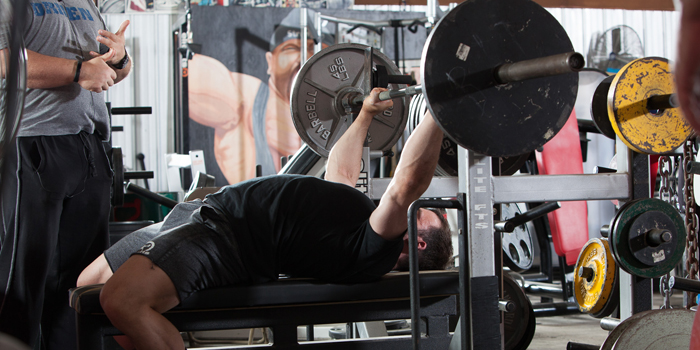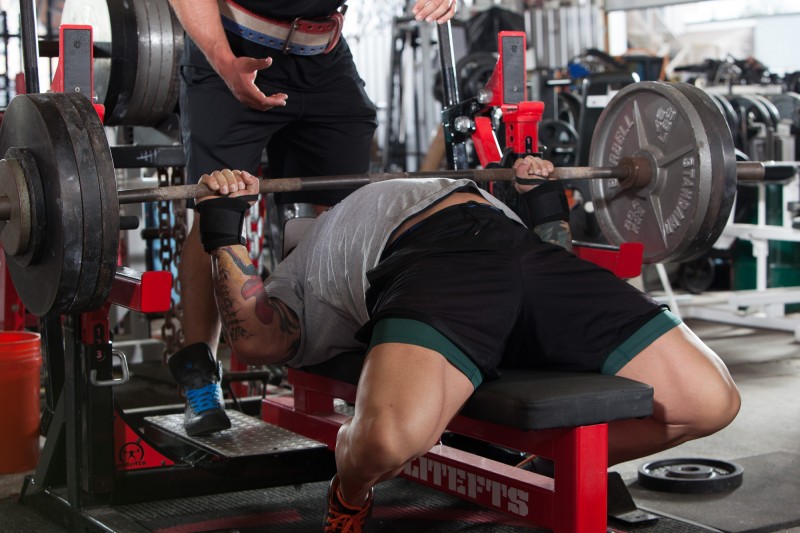
Frustration, hate, and loathing are just a few of the words I would use to describe benching over the last 20 years. Fortunately, in the past five years, I have learned to love the struggle, the puzzle, and the nemesis that is my bench press. It will take a long time to unravel everything and put it back together so you can make progress on the lift that you are least suited to excel. Do not let that last statement deter you from greatness. There have been many great long-armed pressers, but know the road may not be easy.
I stand a height just under 70 inches with a wingspan close to 76 inches. That is great for deadlifting but makes the press quite longer. Understanding your body structure will help you design your training. Long arms mean you will have a long bench stroke. You need to do everything in your power to make yourself successful.
Tip 1: Leg Drive
To tuck the feet or not to tuck, that is the question. When I started my powerlifting journey, Louie Simmons tried to teach me to bench press like Fred Bolt. It was clear that I was not Fred Bolt, but more importantly, I did not have the musculature at that time to bench with my feet out. I tried for two years and floundered. Once I moved into an area where the Metal Militia had a heavy influence, I learned to tuck my feet.
RELATED: Down with the Decline?
Tucking your feet will shorten your bench stroke with a loss of leg drive. If you tend to loosen up or chase your belly as you lower the bar, this is the way to go. As your setup improves and you can get your arch set, your stroke will shorten. As my upper back strength improved, I was able to untuck my feet again. I then added more leg drive and addressed my weakness off my chest. But it wasn’t until I gained enough weight to add the leverage needed.
Bonus Tip: If your floor press and bench are very close to the same weight, your leg drive sucks. Tucking your feet is the best option since you are not getting much out of your legs. Still, work to improve leg drive.

Tip 2: Gain Weight
The easiest way to improve your bench is to gain weight. My bench was stagnant until I moved from the 220 weight class to the 242. A gain of 10 and 20 pounds of bodyweight netted me nearly 100 pounds over the next few years. Weight moves weight, and it will cut down the range of motion. Your recovery will also improve with the right foods.
Staying lean is great, but there will be a time when your bench is stuck, and you will need to gain weight. If you want to be great, gaining weight to get strong and leaning out to compete is part of the game. At 5’9” I would have been the strongest at a bodyweight near 275. I got as far as 260 then worked to lean out to 220, keeping much of my strength. This process was over 10 years. It will take time, but the more mass you can pack on, the more it will help your bench. If your deadlift starts to move backward, stop the weight gain.
Tip 3: Grease the Groove
When it comes to maximum weights, a little out of groove means a miss. Longer arms equate to a longer press. If you touch ¼'' too high or too low, it changes the whole bar path—this could put you out of position by an inch at lockout. It is going to happen, so it is best to get strong in those bad positions.
MORE: 8 Lightweight Exercises for a Massive Shoulder Pump
Steep incline with a close grip will be a tough one for long arm lifters. Too low and you will never finish the lift. The lats are taken out, and you will need more shoulders to get the bar moving. There is so much room for error that if you get better at this, I guarantee a better bench. Much like overhead pressing, I would highly recommend working those exercises that make your press longer and harder. These used as builders will move your bench press up.
Select the exercise that will improve your bench press and use a rep scheme you can follow long-term progressively. One part of this is greasing the groove, and the other part is building the muscles with submaximal weights. If you end up in a bad position with lighter weights, you can learn to recover and put yourself in better positions as you fatigue. It doesn’t matter if you choose to do JM Blakely’s 6x6, 5/3/1 for supplemental work or anything else. Put in the work week after week, and you will continue to see improvement by greasing the groove.
As a long-armed lifter, you will need to maximize your technique and your training. You will have to put in more effort because the parts must be stronger than those with big bellies and short arms. Play your game at the meet and put on three successful attempts knowing your big pull will be where you blow past those with better subtotals. Don’t give up because it is hard, embrace it and push ahead harder.










